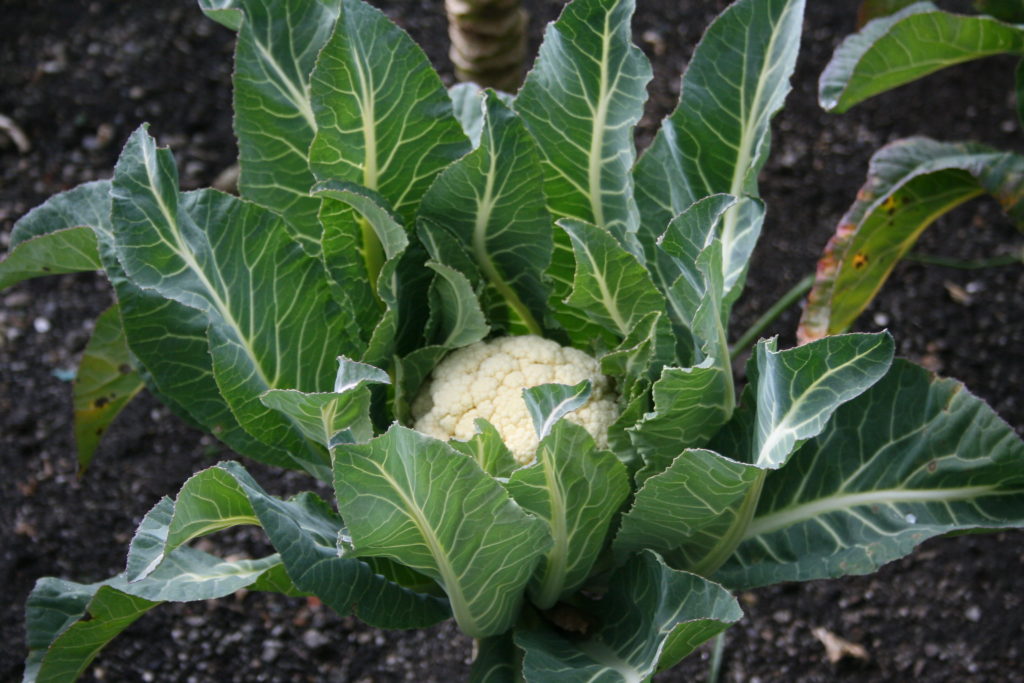There are hundreds of varieties of cauliflower. It was originally cultivated from a type of wild cabbage. Cauliflower is a type of brassica vegetable, similar to broccoli, Brussels sprouts, kale, cabbage, and many more. Its name literally means “cabbage flower.” Cauliflower can be enjoyed raw, pickled, roasted, baked, and grilled. Cauliflower has this unique characteristic that allows it to be crumbled into tiny pieces that can be used in a cauliflower salad or as a pizza crust! It can also be sliced into “cauliflower steaks” and grilled as a vegan dish.
Purple cauliflower is an eye-catching addition to any garden. It tends to have a milder flavor than the typical white variants. Cauliflower is also packed with nutrients as it is high in vitamin C, B, K, fiber, and antioxidants.
Planting Cauliflower in Your Garden

Cauliflower is biennial and thrives in full sun, except in warm climates it prefers partial sun. Soil should be neutral to slightly acidic 6.0 – 7.0 pH and loamy. Spring planting should be a few weeks before the last frost, and Summer plantings should be in late Summer. Cauliflower seed should be planted half an inch deep and 18 inches apart. When transplanting, dig container sized holes and space each plant 18 inches apart. Large containers can be employed for cauliflower. Containers should be 12 inches deep and 18 inches across. Applying a 5-10-10 npk fertilizer is also recommended when growing cauliflower.
It is vital you pay attention to the outside temperature while growing cauliflower. Cauliflower is prone to bolting and will cause it to flower very early and not fully develop. The ideal temperature for cauliflower is 60 to 70 degrees. If you are planting in a warm climate, and it is too hot outside, considering bringing your cauliflower containers inside to protect them from the sun’s scorching rays.
While planting cauliflower, avoid planting tomatoes, peas, or strawberries near it. These plants will eat up all the important nutrients cauliflower needs, stunting its growth. On the other hand, beans, celery, and onions are perfect companion plants for cauliflower. It should be noted that beans and onions should not be planted together though.
Harvesting Cauliflower
Depending on the variety, cauliflower is ready to be harvested from 50 to 100 days after germination. Cauliflower heads should appear tightly packed and 6-8 inches in diameter. Using a large knife, cut the head at the base to remove it. If you notice small heads that appear to be flowering, they should be harvested immediately to stop the flowering process.
Storing cauliflower is easy, each head can be placed in a plastic bag and last at least a week in the refrigerator. Cauliflower can also last a year in the freezer if it properly blanched first. Cut the cauliflower into small pieces then boil them in water for three minutes. After 3 minutes, remove the cauliflower from the boil and submerge them in an ice bath for several minutes then put them into a plastic bag and freeze.

Cauliflower Pests and Diseases
Aphids will cause the cauliflower leaves to yellow, distort and curl. They also leave behind a sticky honeydew and black sooty mold. Applying an insecticidal soap or neem oil should help. Also, consider planting native flowers to invited beneficial insects into your garden to eat the aphids.
Black rot is a type of fungus that will cause the leaves to yellow and develop black veins. Plants infected with this fungus must be discarded.
Cabbage loopers and cabbageworms are caterpillars that will chew on the leaves of your cauliflower. Utilizing insecticides with the bacteria Bacillus thuringiensis (BT) will help. You can also hand remove these caterpillars.
Cabbage root maggots grow into tiny flies that will cause the flowers to wilt and turn off-color. The maggots will also feed on the roots of your cauliflower. Adding hanging sticky yellow traps to catch the flies and diatomaceous earth or tin rings around the base of your cauliflower to manage the maggots.
Clubroot is a fungus that will cause the roots to swell and the leaves to turn yellow and stunt. Managing this fungus is done by maintaining a 7.2 pH soil. If clubroot infects your plant, it will need to be thrown out.
Downy mildew will cause a yellowish cottony fungus to grow on your cauliflower. Applying a copper-based fungicide and neem oil should help get downy mildew under control.
Thrips are insects that will leave white patches with silver streaks. Eventually the leaves will brown and blister causing scaring and leaf curl. Remove any leaves with a thrip infestation and plant native plants that invite beneficial insects into your garden. Adult thrips can be caught by hanging yellow sticky traps in your garden.
White rust will leave white, green, and yellow blisters on the cauliflower leaves. Over time white rust will cause the cauliflower to distort and infect the stem which will cause it to rot. Infected crops must be destroyed, and the garden must have the crops rotated.

Starting a Cauliflower Garden
Getting started with cauliflower is easy. After you pick the perfect location, start planning your entire garden with Hortisketch. Hortisketch is a garden planner that not only makes it easy to plan your garden, but it takes the guess work out of when to sow, grow, and harvest. Its dynamic growing calendar provides all the necessary growing dates based on your zip code. Start planting and planning cauliflower today!











